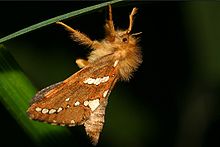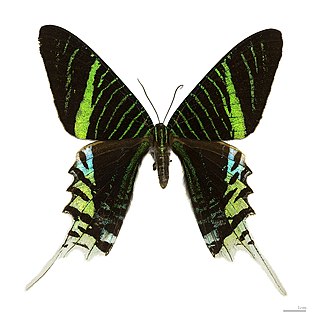
The Uraniidae are a family of moths containing four subfamilies, 90 genera, and roughly 700 species. The family is distributed throughout the tropics of the Americas, Africa and Indo-Australia. Some of the tropical species are known for their bright, butterfly-like colors and are called sunset moths. Such moths are apparently toxic and the bright colors are a warning to predators.

The Hepialidae are a family of insects in the lepidopteran order. Moths of this family are often referred to as swift moths or ghost moths.

The Drepanidae are a family of moths with about 660 species described worldwide. They are generally divided in three subfamilies, which share the same type of hearing organ. Thyatirinae, previously often placed in their own family, bear a superficial resemblance to Noctuidae. Many species in the drepanid family have a distinctively hook-shaped apex to the fore wing, leading to their common name of hook-tips.
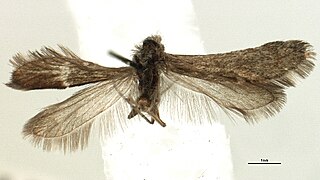
Heterobathmia is a genus of Lepidoptera. It is the only genus in the suborder Heterobathmiina, as well as in the superfamily Heterobathmioidea and in the family Heterobathmiidae. Primitive, day-flying, metallic moths confined to southern South America, the adults eat the pollen of Nothofagus or southern beech and the larvae mine the leaves. Most known species are undescribed.

Schreckensteinioidea is a superfamily in the insect order Lepidoptera containing a single family, Schreckensteiniidae, or "bristle-legged moths", because of the stout spines on the hindlegs. The superfamily and family were both described by Thomas Bainbrigge Fletcher in 1929. The relationships of this family within the group apoditrysia are currently uncertain. One of the species, the blackberry skeletoniser, is widespread and common across Europe and has been introduced as a biological control to Hawaii, whilst three species of Corsocasis occur in South East Asia.
Simaethistoidea is an obscure superfamily of pyralid-like moths with two genera, whose biology and relationships among the Ditrysia is currently unknown, namely the Australian Metaprotus and the China and North Indian Simaethistis.

Neopseustidae is a small family of day and night-flying "archaic bell moths" in the order Lepidoptera. They are classified into their own superfamily Neopseustoidea and infraorder Neopseustina. Four genera are known. These primitive moths are restricted to South America and Southeast Asia. Their biology is unknown.
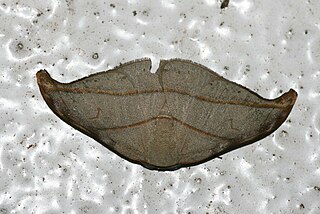
Drepanoidea is the superfamily of "hook tip moths". See Minet and Scoble (1999) for a comprehensive overview.

Nepticuloidea is a superfamily of usually very small monotrysian moths that are characterised by small or large eyecaps over the compound eyes. It comprises two families, the "pigmy moths" (Nepticulidae), with 12 genera which are very diverse worldwide and are usually leaf miners, and the "white eyecap moths" (Opostegidae), also worldwide but with five genera and about a ninth as many species, whose biology is less well known.

Adeloidea is a superfamily of primitive monotrysian moths in the order Lepidoptera which consists of leafcutters, yucca moths and relatives. This superfamily is characterised by a piercing, extensible ovipositor used for laying eggs in plants. Many species are day-flying with metallic patterns.

Copromorphidae, the "tropical fruitworm moths", is a family of insects in the lepidopteran order. These moths have broad, rounded forewings, and well-camouflaged scale patterns. Unlike Carposinidae the mouthparts include "labial palps" with the second rather than third segment the longest. With other unusual structural characteristics of the caterpillar and adult, it could represent the sister lineage of all other extant members of this superfamily. The genus Sisyroxena from Madagascar is also notable for its unusual venation and wing scale sockets.

Epicopeiidae is a family of insects in the order Lepidoptera. They are known as oriental swallowtail moths as they closely resemble some oriental swallowtail butterflies. Epicopeiidae have highly varied structure in regards to body size and wing shape. Epicopeiidaen wing patterns are involved in complicated mimicry rings.
Whalleyana is an enigmatic genus of moths in the lepidopteran group Obtectomera, endemic to Madagascar. The genus contains two species, whose biology are unknown. The genus had been placed in the picture-winged leaf moths, (Thyrididae), but then was placed in its own family, and later elevated to its own superfamily ; see also Fänger (2004). The genus was named after Paul E. S. Whalley, a British entomologist. Genomic studies have found them to be most closely related to Callidulidae, and it is suggested that they should be placed in Calliduloidea.
The Palaeosetidae or miniature ghost moths are a family of insects in the order Lepidoptera contained within the superfamily Hepialoidea.
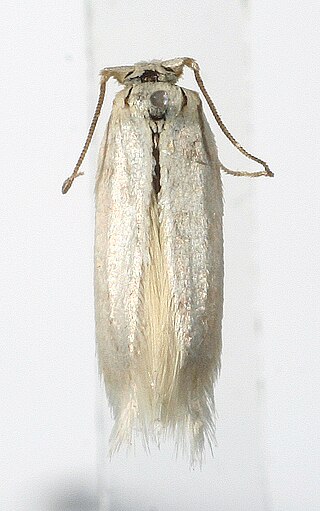
Opostegidae or "white eyecap moths" is a family of insects in the order Lepidoptera that is characterised by particularly large eyecaps over the compound eyes. Opostegidae are most diverse in the New World tropics.
Neotheoridae, or Amazonian primitive ghost moths, is a primitive family of insects in the lepidopteran order containing a single genus and species, Neotheora chiloides.
Prototheora is a genus of moths. It is the only genus of the Prototheoridae, or the African primitive ghost moths, a family of insects in the lepidopteran order, contained in the superfamily Hepialoidea. These moths are endemic to Southern Africa.
The Exoporia are a group of primitive Lepidoptera comprising the superfamilies Mnesarchaeoidea and Hepialoidea. They are a natural group or clade. Exoporia is the sister group of the lepidopteran infraorder Heteroneura. They are characterised by their unique female reproductive system which has an external groove between the ostium bursae and the ovipore by which the sperm is transferred to the egg rather than having the mating and egg-laying parts of the abdomen with a common opening (cloaca) as in other nonditrysian moths, or with separate openings linked internally by a "ductus seminalis" as in the Ditrysia. See Kristensen for other exoporian characteristics.

The Monotrysia are a group of moths in the lepidopteran order, not currently considered to be a natural group or clade. The group is so named because the female has a single genital opening for mating and laying eggs, in contrast to the rest of the Lepidoptera (Ditrysia), which have two female reproductive openings. Later classifications used Monotrysia in a narrower sense for the nonditrysian Heteroneura, but this group was also found to be paraphyletic with respect to Ditrysia. Apart from the recently discovered family Andesianidae, most of the group consists of small, relatively understudied species.

Micropterigoidea is the superfamily of "mandibulate archaic moths", all placed in the single family Micropterigidae, containing currently about twenty living genera. They are considered the most primitive extant lineage of lepidoptera, and the sole superfamily in the suborder Zeugloptera. The name comes from the Greek for mikros, little and pterux, a wing. Unique among the Lepidoptera, these moths have chewing mouthparts rather than a proboscis, and are seen feeding, often in large aggregations, on the pollen of the flowers of many herbaceous plants, shrubs and trees. The fossil record of the group goes back to the middle-late Jurassic with the earliest known species being Auliepterix from the Karabastau Formation in Kazakhstan.
